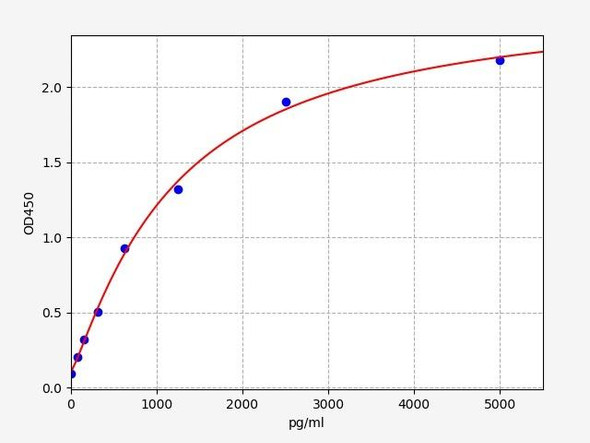Human Atrial natriuretic peptide receptor 1 (NPR1) ELISA Kit
- SKU:
- HUEB2196
- Product Type:
- ELISA Kit
- Size:
- 96 Assays
- Uniprot:
- P16066
- Range:
- 0.312-20 ng/mL
- ELISA Type:
- Sandwich
- Synonyms:
- NPR1, Atrial natriuretic peptide receptor 1, ANPa
- Reactivity:
- Human
Description
| Product Name: | Human Atrial natriuretic peptide receptor 1 (NPR1) ELISA Kit |
| Product Code: | HUEB2196 |
| Alias: | Atrial natriuretic peptide receptor 1, Atrial natriuretic peptide receptor type A, ANP-A, ANPR-A, NPR-A, Guanylate cyclase A, GC-A, NPR1, ANPRA, 4.6.1.2 |
| Uniprot: | P16066 |
| Reactivity: | Human |
| Range: | 0.312-20 ng/mL |
| Detection Method: | Sandwich |
| Size: | 96 Assay |
| Storage: | Please see kit components below for exact storage details |
| Note: | For research use only |
| UniProt Protein Function: | ANPA: natriuretic peptide receptor A, which mediates natriuretic, diuretic, and vasorelaxing actions of the natriuretic peptides. Contains five functional domains: an extracellular ligand-binding domain, a single membrane-spanning region, and intracellularly a protein kinase homology domain, a helical hinge region involved in oligomerization, and a carboxyl-terminal guanylyl cyclase catalytic domain. Belongs to the adenylyl cyclase class-4/guanylyl cyclase family. Has guanylate cyclase activity on binding of ANF. Hypertensive SHR Rat has polymorphism at the locus. Human non-coding polymorphisms can alter expression up to two-fold, and have been associated with hypertension. A coding SNP is associated with hypertension and myocardial infarction. |
| UniProt Protein Details: | Protein type:Guanylyl cyclase; Protein kinase, RGC; Lyase; Protein kinase, dual-specificity (receptor); Nucleotide Metabolism - purine; Kinase, protein; EC 4.6.1.2; Receptor, misc.; Membrane protein, integral; RGC group; RGC family Chromosomal Location of Human Ortholog: 1q21-q22 Cellular Component: guanylate cyclase complex, soluble; integral to plasma membrane; plasma membrane; receptor complex Molecular Function:adenylate cyclase activity; ATP binding; GTP binding; guanylate cyclase activity; hormone binding; natriuretic peptide receptor activity; peptide hormone binding; peptide receptor activity, G-protein coupled; protein kinase activity; protein kinase binding Biological Process: body fluid secretion; cell surface receptor linked signal transduction; cGMP biosynthetic process; dopamine metabolic process; G-protein coupled receptor protein signaling pathway; negative regulation of angiogenesis; negative regulation of cell growth; negative regulation of smooth muscle cell proliferation; positive regulation of cGMP biosynthetic process; protein amino acid phosphorylation; receptor guanylyl cyclase signaling pathway; regulation of blood pressure; regulation of vascular permeability; regulation of vasodilation |
| NCBI Summary: | Guanylyl cyclases, catalyzing the production of cGMP from GTP, are classified as soluble and membrane forms (Garbers and Lowe, 1994 [PubMed 7982997]). The membrane guanylyl cyclases, often termed guanylyl cyclases A through F, form a family of cell-surface receptors with a similar topographic structure: an extracellular ligand-binding domain, a single membrane-spanning domain, and an intracellular region that contains a protein kinase-like domain and a cyclase catalytic domain. GC-A and GC-B function as receptors for natriuretic peptides; they are also referred to as atrial natriuretic peptide receptor A (NPR1) and type B (NPR2; MIM 108961). Also see NPR3 (MIM 108962), which encodes a protein with only the ligand-binding transmembrane and 37-amino acid cytoplasmic domains. NPR1 is a membrane-bound guanylate cyclase that serves as the receptor for both atrial and brain natriuretic peptides (ANP (MIM 108780) and BNP (MIM 600295), respectively).[supplied by OMIM, May 2009] |
| UniProt Code: | P16066 |
| NCBI GenInfo Identifier: | 113912 |
| NCBI Gene ID: | 4881 |
| NCBI Accession: | P16066.1 |
| UniProt Secondary Accession: | P16066,Q5SR08, Q6P4Q3, B0ZBF0, |
| UniProt Related Accession: | P16066 |
| Molecular Weight: | 118,919 Da |
| NCBI Full Name: | Atrial natriuretic peptide receptor 1 |
| NCBI Synonym Full Names: | natriuretic peptide receptor 1 |
| NCBI Official Symbol: | NPR1 |
| NCBI Official Synonym Symbols: | ANPa; NPRA; ANPRA; GUC2A; GUCY2A |
| NCBI Protein Information: | atrial natriuretic peptide receptor 1 |
| UniProt Protein Name: | Atrial natriuretic peptide receptor 1 |
| UniProt Synonym Protein Names: | Atrial natriuretic peptide receptor type A; ANP-A; ANPR-A; NPR-A; Guanylate cyclase A; GC-A |
| Protein Family: | Phosphoglucomutase |
| UniProt Gene Name: | NPR1 |
| UniProt Entry Name: | ANPRA_HUMAN |
| Component | Quantity (96 Assays) | Storage |
| ELISA Microplate (Dismountable) | 8×12 strips | -20°C |
| Lyophilized Standard | 2 | -20°C |
| Sample Diluent | 20ml | -20°C |
| Assay Diluent A | 10mL | -20°C |
| Assay Diluent B | 10mL | -20°C |
| Detection Reagent A | 120µL | -20°C |
| Detection Reagent B | 120µL | -20°C |
| Wash Buffer | 30mL | 4°C |
| Substrate | 10mL | 4°C |
| Stop Solution | 10mL | 4°C |
| Plate Sealer | 5 | - |
Other materials and equipment required:
- Microplate reader with 450 nm wavelength filter
- Multichannel Pipette, Pipette, microcentrifuge tubes and disposable pipette tips
- Incubator
- Deionized or distilled water
- Absorbent paper
- Buffer resevoir
*Note: The below protocol is a sample protocol. Protocols are specific to each batch/lot. For the correct instructions please follow the protocol included in your kit.
Allow all reagents to reach room temperature (Please do not dissolve the reagents at 37°C directly). All the reagents should be mixed thoroughly by gently swirling before pipetting. Avoid foaming. Keep appropriate numbers of strips for 1 experiment and remove extra strips from microtiter plate. Removed strips should be resealed and stored at -20°C until the kits expiry date. Prepare all reagents, working standards and samples as directed in the previous sections. Please predict the concentration before assaying. If values for these are not within the range of the standard curve, users must determine the optimal sample dilutions for their experiments. We recommend running all samples in duplicate.
| Step | |
| 1. | Add Sample: Add 100µL of Standard, Blank, or Sample per well. The blank well is added with Sample diluent. Solutions are added to the bottom of micro ELISA plate well, avoid inside wall touching and foaming as possible. Mix it gently. Cover the plate with sealer we provided. Incubate for 120 minutes at 37°C. |
| 2. | Remove the liquid from each well, don't wash. Add 100µL of Detection Reagent A working solution to each well. Cover with the Plate sealer. Gently tap the plate to ensure thorough mixing. Incubate for 1 hour at 37°C. Note: if Detection Reagent A appears cloudy warm to room temperature until solution is uniform. |
| 3. | Aspirate each well and wash, repeating the process three times. Wash by filling each well with Wash Buffer (approximately 400µL) (a squirt bottle, multi-channel pipette,manifold dispenser or automated washer are needed). Complete removal of liquid at each step is essential. After the last wash, completely remove remaining Wash Buffer by aspirating or decanting. Invert the plate and pat it against thick clean absorbent paper. |
| 4. | Add 100µL of Detection Reagent B working solution to each well. Cover with the Plate sealer. Incubate for 60 minutes at 37°C. |
| 5. | Repeat the wash process for five times as conducted in step 3. |
| 6. | Add 90µL of Substrate Solution to each well. Cover with a new Plate sealer and incubate for 10-20 minutes at 37°C. Protect the plate from light. The reaction time can be shortened or extended according to the actual color change, but this should not exceed more than 30 minutes. When apparent gradient appears in standard wells, user should terminatethe reaction. |
| 7. | Add 50µL of Stop Solution to each well. If color change does not appear uniform, gently tap the plate to ensure thorough mixing. |
| 8. | Determine the optical density (OD value) of each well at once, using a micro-plate reader set to 450 nm. User should open the micro-plate reader in advance, preheat the instrument, and set the testing parameters. |
| 9. | After experiment, store all reagents according to the specified storage temperature respectively until their expiry. |
When carrying out an ELISA assay it is important to prepare your samples in order to achieve the best possible results. Below we have a list of procedures for the preparation of samples for different sample types.
| Sample Type | Protocol |
| Serum | If using serum separator tubes, allow samples to clot for 30 minutes at room temperature. Centrifuge for 10 minutes at 1,000x g. Collect the serum fraction and assay promptly or aliquot and store the samples at -80°C. Avoid multiple freeze-thaw cycles. If serum separator tubes are not being used, allow samples to clot overnight at 2-8°C. Centrifuge for 10 minutes at 1,000x g. Remove serum and assay promptly or aliquot and store the samples at -80°C. Avoid multiple freeze-thaw cycles. |
| Plasma | Collect plasma using EDTA or heparin as an anticoagulant. Centrifuge samples at 4°C for 15 mins at 1000 × g within 30 mins of collection. Collect the plasma fraction and assay promptly or aliquot and store the samples at -80°C. Avoid multiple freeze-thaw cycles. Note: Over haemolysed samples are not suitable for use with this kit. |
| Urine & Cerebrospinal Fluid | Collect the urine (mid-stream) in a sterile container, centrifuge for 20 mins at 2000-3000 rpm. Remove supernatant and assay immediately. If any precipitation is detected, repeat the centrifugation step. A similar protocol can be used for cerebrospinal fluid. |
| Cell culture supernatant | Collect the cell culture media by pipette, followed by centrifugation at 4°C for 20 mins at 1500 rpm. Collect the clear supernatant and assay immediately. |
| Cell lysates | Solubilize cells in lysis buffer and allow to sit on ice for 30 minutes. Centrifuge tubes at 14,000 x g for 5 minutes to remove insoluble material. Aliquot the supernatant into a new tube and discard the remaining whole cell extract. Quantify total protein concentration using a total protein assay. Assay immediately or aliquot and store at ≤ -20 °C. |
| Tissue homogenates | The preparation of tissue homogenates will vary depending upon tissue type. Rinse tissue with 1X PBS to remove excess blood & homogenize in 20ml of 1X PBS (including protease inhibitors) and store overnight at ≤ -20°C. Two freeze-thaw cycles are required to break the cell membranes. To further disrupt the cell membranes you can sonicate the samples. Centrifuge homogenates for 5 mins at 5000xg. Remove the supernatant and assay immediately or aliquot and store at -20°C or -80°C. |
| Tissue lysates | Rinse tissue with PBS, cut into 1-2 mm pieces, and homogenize with a tissue homogenizer in PBS. Add an equal volume of RIPA buffer containing protease inhibitors and lyse tissues at room temperature for 30 minutes with gentle agitation. Centrifuge to remove debris. Quantify total protein concentration using a total protein assay. Assay immediately or aliquot and store at ≤ -20 °C. |
| Breast Milk | Collect milk samples and centrifuge at 10,000 x g for 60 min at 4°C. Aliquot the supernatant and assay. For long term use, store samples at -80°C. Minimize freeze/thaw cycles. |










